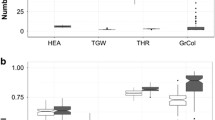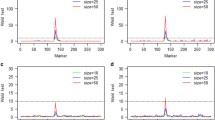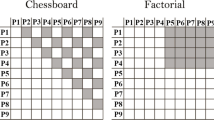Abstract
Many studies already investigated marker-assisted selection (MAS) efficiency but mainly in biparental populations. Connected multiparental populations address a broader diversity and confer a gain of power for QTL detection which must be beneficial for MAS. Our objective was to compare multiparental connected designs to biparental populations taken separately for MAS and phenotypic selection. We first detected QTL for flowering time and grain yield in an experimental maize design involving four parental inbred lines crossed to produce six different biparental populations and confirmed the advantage of multiparental connected designs over biparental populations for QTL detection. Based on these results we performed stochastic simulations to evaluate the expected efficiency of four generations of MAS and phenotypic selection. Different parameters were considered: trait heritability, genetic architecture and whether QTL were assumed to be known or have to be detected. Genetic gains were higher in the multiparental design than on average over the biparental populations considered separately, especially when favourable alleles were equally distributed among parental lines. When QTL detection was included in the simulation process, we found that type I error risk considered for declaring QTL as significant should be adapted to the design. Type I error risks leading to the best response were higher for the biparental populations than for the multiparental design. Besides addressing a broader diversity, multiparental designs increase the power of QTL detection, which reinforces their superiority over biparental designs for MAS. Application of MAS to multiparental designs therefore appears promising to accelerate genetic gain in plant breeding programs.




Similar content being viewed by others
Abbreviations
- MAS:
-
Marker-assisted selection
- QTL:
-
Quantitative trait loci
References
Bernardo R (2004) What proportion of declared QTL in plants are false? Theor Appl Genet 109:419–424
Bernardo R, Moreau L, Charcosset A (2006) Optimizing the number and fitness of selected individuals in recurrent selection. Crop Sci 46:1972–1980
Blanc G, Charcosset A, Mangin B et al (2006) Connected populations for detecting QTL and testing for epistasis, an application in maize. Theor Appl Genet 113:206–224
Charcosset A, Mangin B, Combes L et al (2000) Heterosis in maize investigated using connected RIL populations, pp. in quantitative genetics and breeding methods: the way ahead. INRA, Paris, France
Charmet G, Robert N, Perretant MR et al (1999) Marker-assisted recurrent selection for cumulating additive and interactive QTLs in recombinant inbred lines. Theor Appl Genet 99:1143–1148
Dekkers JC, Chakraborty R, Moreau L (2002) Optimal selection on two quantitative trait loci with linkage. Genet Sel Evol 34:171–192
Gimelfarb A, Lande R (1994) Simulation of marker-assisted selection in hybrid populations. Genet Res 63:39–47
Gimelfarb A, Lande R (1995) Marker-assisted selection and marker-QTL association in hybrid populations. Theor Appl Genet 91:522–528
Haldane JBS (1919) The combination of linkage values and the calculation of distances between the loci of linked factors. J Genetics 8:299–309
Haley CS, Knott SA (1992) A simple regression method for mapping quantitative trait loci in line crosses using flanking markers. Heredity 69:315–324
Hospital F, Goldringer I, Openshaw S (2000) Efficient marker-based recurrent selection for multiple quantitative trait loci. Genet Res 75:357–368
Hospital F, Moreau L, Lacoudre F et al (1997) More on the efficiency of marker-assisted selection. Theor Appl Genet 95:1181–1189
Jannink JL, Jansen RC (2001) Mapping epistatic quantitative trait loci with one-dimensional genome searches. Genetics 157:445–454
Jourjon MF, Jasson S, Marcel J et al (2005) MCQTL: multi-allelic QTL mapping in multi-cross design. Bioinformatics 21:128–130
Knapp SJ, Stroup WW, Ross WM (1985) Exact confidence intervals for heritability on a progeny mean basis. Crop Sci 25:192–194
Lande R, Thompson R (1990) Efficiency of marker-assisted selection in the improvement of quantitative traits. Genetics 124:743–756
Lander ES, Green P, Abrahamson J et al (1987) MAPMAKER: an interactive computer package for constructing primary genetic linkage maps of experimental and natural populations. Genomics 1:174–181
Moreau L, Charcosset A, Hospital F et al (1998) Marker-assisted selection efficiency in populations of finite size. Genetics 148:1353–1365
Moreau L, Charcosset A, Gallais A (2004) Experimental evaluation of several cycles of marker-assisted selection in maize. Euphytica 137:111–118
Openshaw S, Frascaroli E (1997) QTL detection and marker-assisted selection for complex traits in maize. In: Proc. 52th Annual Corn and Sorghum Research Conference., ed by ASTA, Washington DC
Rebai A, Goffinet B (1993) Power of tests for QTL detection using replicated progenies derived from a diallel cross. Theor Appl Genet 86:1014–1022
Rebai A, Goffinet B (2000) More about quantitative trait locus mapping with diallel designs. Genet Res 75:243–247
Van Berloo R, Stam P (1998) Marker-assisted selection in autogamous RIL populations : a simulation study. Theor Appl Genet 96:147–154
Zhang W, Smith C (1992) Computer simulation of marker-assisted selection utilizing linkage disequilibrium. Theor Appl Genet 83:813–820
Zhang W, Smith C (1993) Simulation of marker-assisted selection utilizing linkage disequilibrium: the effect of several additional factors. Theor Appl Genet 86:492–496
Author information
Authors and Affiliations
Corresponding author
Rights and permissions
About this article
Cite this article
Blanc, G., Charcosset, A., Veyrieras, JB. et al. Marker-assisted selection efficiency in multiple connected populations: a simulation study based on the results of a QTL detection experiment in maize. Euphytica 161, 71–84 (2008). https://doi.org/10.1007/s10681-007-9607-z
Received:
Accepted:
Published:
Issue Date:
DOI: https://doi.org/10.1007/s10681-007-9607-z




